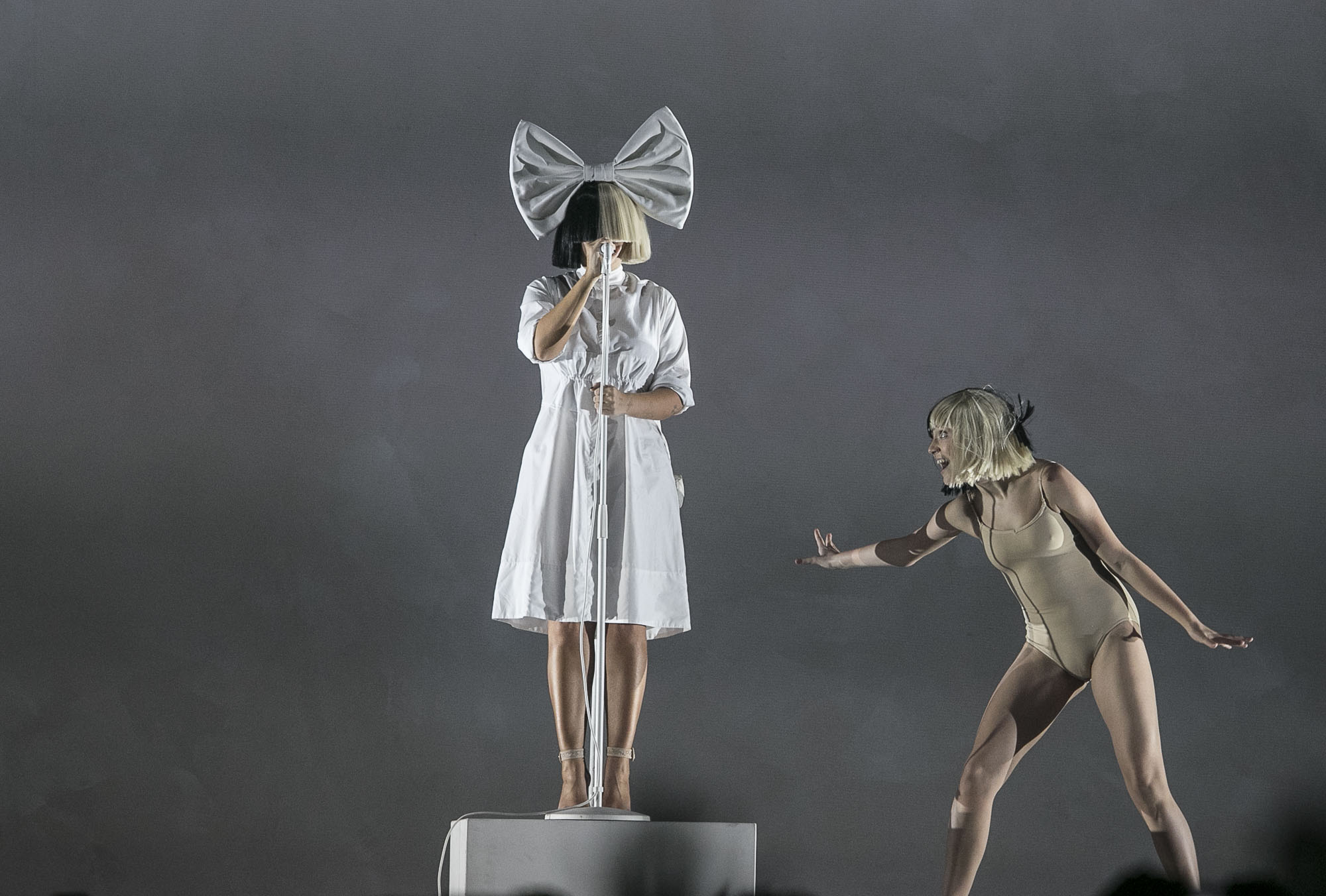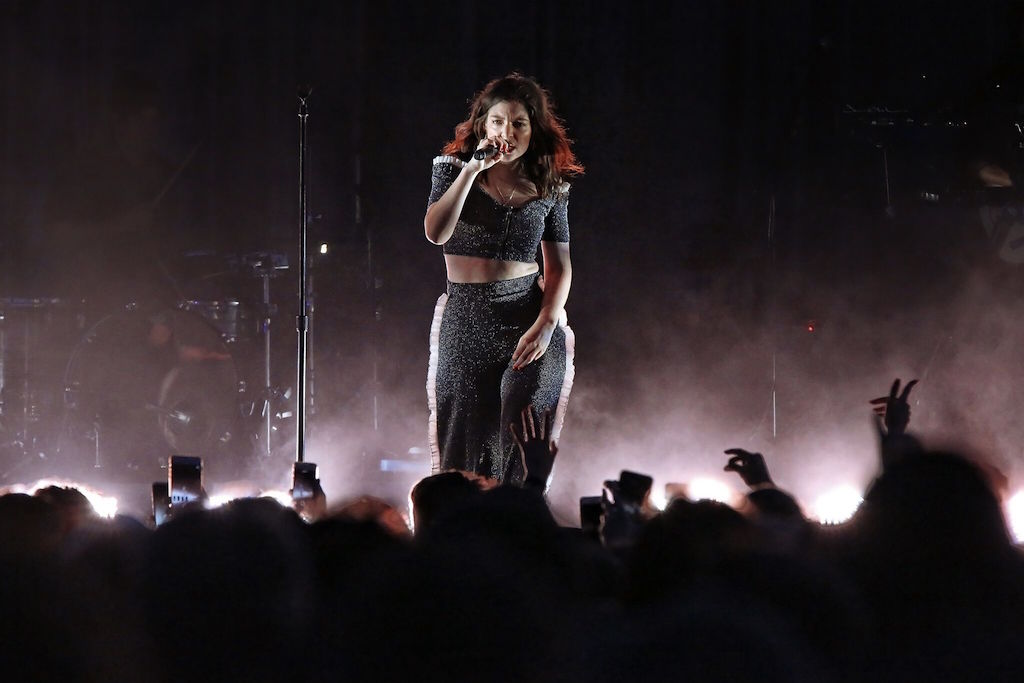What Happened When Sia And The Weeknd Hit Sydney On The Same Night
Two pop superstars, two very different shows.

Pop fans were spoilt for choice in Sydney this past weekend. Not only did Sia bring Charli XCX, MØ and Amy Shark through for her first Australian tour in six years, R&B hitmaker The Weeknd made his debut Australian tour with French Montana in tow. DAVID JAMES YOUNG went to both shows and lived to tell the tale.
It was one mammoth announcement after another for Australian pop fans. First was the return of Sia, the Adelaide girl made good who simultaneously ascended hitherto unseen heights of success while completely removing her public profile. Oh, and she had a trio of hit-making ladies to back her up in the form of Charli XCX, MØ and Amy Shark — just for good measure.
Next came The Weeknd, the Canadian R&B sensation making his maiden voyage to Australia after years of build-up and more than enough hits to justify the trip. The excitement for both tours was palpable… until the horror of the situation set in for Sydney-siders.
For whatever reason, December 2 was decided as the night for both Sia’s show at Allianz Stadium in Moore Park and for The Weeknd’s first-ever Sydney show at Olympic Park’s Qudos Bank Arena. It meant making a brutal Sophie’s Choice, leaving many conflicted as to which show to go with. Out of the darkness came light, however, when demand allowed for The Weeknd to add a second show the night after — and this inexplicable clash of the titans became the ultimate “¿porque no los dos?” of 2017.
Neither artist came to their grand-scale shows alone. Sia’s ensemble cast of support acts lifted what was already a special night into something truly extraordinary. Despite miserable, drizzly weather coming down, each of the three singers brought their own energy and flair to the stage.
Amy Shark has gone from people talking over her sets at RSLs to holding control over thousands of people through her dark, electronically-tinged pop smashes. MØ is arguably better known for songs that “feat. MØ” than songs actually by her, but watching her boundless energy and excitability made her an utterly enthralling prospect. That brings us to Charli XCX, who pre-empted her arrival with a glittery-pink backdrop and a reflective-surface DJ booth — she came to fucking party, and fucking party she did.
Look at the run of hits between them: ‘Weekends,’ ‘Adore,’ ‘Cold Water,’ ‘Lean On,’ ‘I Love It,’ ‘Boys,’ ‘Fancy,’ ‘Boom Clap.’ That’s enough sing-alongs for an entire wedding playlist — and no grey cloud could cast over that level of radiating sunshine.

Photo: James Guiney
Over on The Weeknd’s side of things, the stakes were a little lower. There was certainly fun to be had — a surprise cameo from A$AP Ferg during French Montana’s set caused a degree of hysteria, and clever DJ choices of ‘Bodak Yellow’ and ‘I Don’t Fuck with You’ riled up the audience in a sea of bouncing hands and shouted raps.
In no way, however, did it level out the way Sia’s bill did. With the two primary crowd directives of “HANDS UP!” and “ONE! TWO! THREE! LET’S GO!”, the support acts were more or less shooting fish in a barrel — making for light and simple entertainment, but nothing all that memorable.
This brings us to the main event of each respective evening, as Sia Furler and Abel Tesfaye played to great fanfare and deafening shrieks from thousands of fans. From the outset, it’s worth noting some of the interesting contrasts between the trajectory each has taken — from an aesthetic standpoint, both have ended up at junctures that are antithetical to their origins.
Furler, for instance, was once entirely open about her public profile and presence — that’s her drawing on her face on the Some People Have Real Problems cover, that’s her wide-eyed and joyous in the “Clap Your Hands” video. As she relocated and reinvented, however, the aesthetic began to circle around her anonymity. Furler now draws the focus to everyone that isn’t her — primarily through a remarkable ensemble of dancers — as she relegated herself to the corner of the stage, barely moving a muscle.
Conversely, consider Tesfaye’s initial emergence with the release of House of Balloons in 2011. Initially, there was next to no information on the man himself — and the only photos that existed were either blurry or not facing the camera. He was shrouded in mystery, which drew listeners in even further. By the time he cracked the mainstream with ‘Can’t Feel My Face’ in 2015, his aesthetic was part and parcel of who he was, from his inimitable hairstyle to his leather-jacket cool.
While Sia moved away from the light, Tesfaye moved into it. In turn, he’s become a consumate showman — with an exceptional backing band, he sauntered around every corner of the stage oozing confidence and classic sex appeal.

Photo: Garry Brandon
The common ground between the two performers — one introverted, one extroverted — is the resonance and power of their voices.
Even with the key of several songs lowered, there is still something immediately striking and devastatingly emotive about Furler’s delivery. This was especially the case when she paid respect to anyone who knew her music before 1000 Forms Of Fear by performing both ‘Soon We’ll Be Found’ and ‘Breathe Me.’ These two songs alone were worth the price of admission, with Furler going on extensive and impressive vocal runs towards the conclusion of each.
As for Tesfaye, it was nothing short of impressive to hear his distinctive vocals replicated in the flesh — and not just because there was six years of build-up to it finally happening. He holds remarkable control over his voice, and made sure to put it to good use during moments like ‘Tell Your Friends’ and the baby-making ‘Earned It.’ Some of the biggest cheers of the night end up going to his drawn-out high notes — and rightfully so.
The Sia tour is weird, arty and minimalist in nature — essentially the opposite of a stadium pop show. The way that the show played out belies that of your usual stadium inhabitants — your Coldplays, your Foo Fighters — to the point that there were probably more than a few confused looks between families wondering what they’d gotten themselves into. Where was the confetti? The beach balls? The pyros? Does she seriously just stand there all night? Full credit deserves to go to Furler and her production team for refusing to compromise on vision, even when playing to the nosebleeds.
Still, there was more than enough going on to tide over Furler’s own stoic presence. For one, the remarkable Maddie Ziegler turned in a perfectly-choreographed performance that cements her status as one of the great dancers of the modern era. That may seem hyperbolic for a child of 14, but after spending an evening watching her every move — even from afar — it’s near-impossible to view her any other way. She leaves everything out there on the stage, confirming beyond any shadow of a doubt that this is what she was born to do.
The video accompaniment also proved to be greatly entertaining, featuring compelling performances from Kristen Wiig, Paul Dano, Tig Notaro and our very own Ben Mendelsohn.

Photo: James Guiney
The central focus of The Weeknd’s live show is a rotating, lit-up triangle that blasts light matching the song’s colour scheme. It’s perhaps an homage to the pyramid used by Starboy collaborators Daft Punk, and it cleverly added an arena-sized indulgence to contrast from the comparatively-minimal stage set-up. Tellingly though, it never stole focus away from Tesfaye himself, nor the songs he was performing. A key common thread emerges yet again: Sia may stand still, and The Weeknd may be strutting like Mick Jagger, but the focus is steadily kept on the music across both performances.
Each show ends quite differently — Sia’s with triumph via ‘The Greatest,’ The Weeknd’s with tragedy via ‘The Hills.’ Both songs hold a deep connection with their audiences — young girls chanting “I got stamina” while their mothers watch with beaming pride; teenagers and twentysomethings in arms howling “When I’m fucked up, that’s the real me.”
Sia and The Weeknd are day and night. Light and dark. A background player and a frontman. When it comes down to it, however, they’re two of the most unique and important voices in pop music right now.
You can try to pit them against one another, but ultimately it is we — the fan, the spectator — that emerges victorious.
—
David James Young is a freelance writer and podcaster. He tweets at @DJYwrites.
—
Article image by James Guiney
